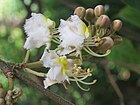Note: This is a project under development. The articles on this wiki are just being initiated and broadly incomplete. You can Help creating new pages.
Hiptage benghalensis - Madhavi lata
Madhavilata is a woody climber with fragrant yellow-white flowers and 3-winged wind dispersed seeds found in India, South-East Asia and the Philippines.
Contents
- 1 Uses
- 2 Parts Used
- 3 Chemical Composition
- 4 Common names
- 5 Properties
- 6 Habit
- 7 Identification
- 8 List of Ayurvedic medicine in which the herb is used
- 9 Where to get the saplings
- 10 Mode of Propagation
- 11 How to plant/cultivate
- 12 Commonly seen growing in areas
- 13 Photo Gallery
- 14 References
- 15 External Links
Uses
Wounds, Ulcers, Burning sensation, Cough, Asthma [1]
Parts Used
{{Parts Used|Bark}, Leaves, Flowers.
Chemical Composition
Common names
| Language | Common name |
|---|---|
| Kannada | Adaraganjee hambu, Madhavi Lathe |
| Hindi | Madhumalati |
| Malayalam | Chittilakody, Njarambodal, Pongapoo, Seethambu, Sitampu |
| Tamil | Vasantakaala malligaim, Adigandi, Adimattam, Atikam, Atikamali, Atikamalikkoti |
| Telugu | Adavi puttangi, Athimutamu, Atimutamu, Bandi guriginja |
| Marathi | Haladvel, Madhavlata, Madhumaalathi |
| Gujarathi | |
| Punjabi | |
| Kashmiri | |
| Sanskrit | Bhramarotsava, Bhumimandapa, Madhavilata, Malati, Vasanti |
| English | Hiptage, Helicopter Flower |
Properties
Reference: Dravya - Substance, Rasa - Taste, Guna - Qualities, Veerya - Potency, Vipaka - Post-digesion effect, Karma - Pharmacological activity, Prabhava - Therepeutics.
Dravya
Rasa
Guna
Veerya
Vipaka
Karma
Prabhava
Habit
Identification
Leaf
| Kind | Shape | Feature |
|---|---|---|
| Simple | Opposite | Leaves opposite 7-12 x 2.5-5 cm, elliptic-oblong to lanceolate, base attenuate or obtuse, apex acuminate, with a pair of glands on petioles at the base of lamina. |
Flower
| Type | Size | Color and composition | Stamen | More information |
|---|---|---|---|---|
| Bisexual | Axillary or terminal racemes | White and yellow | 10 | Sepals 5, 6-7 mm long, oblong, one larger with a large gland at the base outside. |
Fruit
| Type | Size | Mass | Appearance | Seeds | More information |
|---|---|---|---|---|---|
| Samara | 4 x 2 cm | Fruit a 3-winged samara, one wing larger | Seeds 0.8-1 cm across, globose |
Other features
List of Ayurvedic medicine in which the herb is used
Where to get the saplings
Mode of Propagation
How to plant/cultivate
Propagation occurs via seeds or cuttings. The seeds are readily dispersed by wind.[4]
Commonly seen growing in areas
Tropical area, Sub tropical area
Photo Gallery
References
External Links
Categories:
- Ayurvedic Herbs known to be helpful to treat Wounds
- Ayurvedic Herbs known to be helpful to treat Ulcers
- Ayurvedic Herbs known to be helpful to treat Burning sensation
- Ayurvedic Herbs known to be helpful to treat Cough
- Ayurvedic Herbs known to be helpful to treat Asthma
- Herbs with Leaves used in medicine
- Herbs with Flowers used in medicine
- Herbs with common name in Kannada
- Herbs with common name in Hindi
- Herbs with common name in Malayalam
- Herbs with common name in Tamil
- Herbs with common name in Telugu
- Herbs with common name in Marathi
- Herbs with common name in Sanskrit
- Herbs with common name in English
- Habit - Climber
- Index of Plants which can be propagated by Seeds
- Index of Plants which can be propagated by Cuttings
- Herbs that are commonly seen in the region of Tropical area
- Herbs that are commonly seen in the region of Sub tropical area
- Herbs
- Malpighiaceae
- Western ghats




